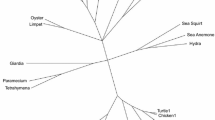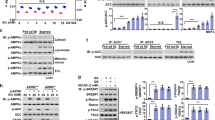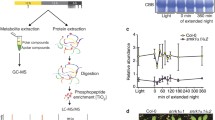Abstract
In response to energy stress (and elevated AMP), the AMP-activated protein kinase (AMPK) coordinates the restoration of energy homeostasis. We determined that AMPK is activated in a model system (desert snail Otala lactea) during a physiological state of profound metabolic rate depression (estivation) in the absence of a rise in AMP. Kinetic characterization indicated a strong increase in AMPK activity and phosphorylation in estivation, consistent with an increase in P-Ser428 LKB, an established regulator of AMPK. Accordingly, ~2-fold increases in AMPKα1 protein and activity were observed with LKB1 immunoprecipitates from estivating snails. In vitro studies determined that AMPK in crude extracts was activated in the presence of cGMP and deactivated in conditions that permitted protein phosphatase type-2A (PP2A) activity. Furthermore, AMPKα1 protein and activity increased in PKG immunoprecipitates from estivating tissues, suggesting a novel role for PKG in the regulation of AMPK in vivo. We evaluated several downstream targets of AMPK. Acetyl-CoA carboxylase (ACC) activity was strongly inhibited in estivation, consistent with increased P-Ser79 content, and in vitro stimulation of AMPK negated citrate’s ability to stimulate ACC aggregation. Analysis of other targets revealed a strong decrease in PPARγ-coactivator 1α expression in both tissues, which was related to decreased gluconeogenic protein expression in hepatic tissue, but no changes in mitochondrial biogenesis markers in muscle. We concluded that AMPK activation in O. lactea aids in facilitating the suppression of anabolic pathways, without necessarily activating ATP-generating catabolism.






Similar content being viewed by others
Abbreviations
- AMPK:
-
AMP-activated protein kinase
- ACC:
-
Acetyl-CoA carboxylase
- PGC1α:
-
PPARγ-coactivator 1α
- PKG:
-
Protein kinase G
- PP2A:
-
Protein phosphatase type-2A
- G6Pase:
-
Glucose-6-phosphatase
- PEPCK:
-
Phosphoenolpyruvate carboxykinase
- NRF1:
-
Nuclear respiratory factor 1
- mtTFA:
-
Mitochondrial transcription factor A
References
Hue L, Rider MH (2007) The AMP-activated protein kinase: more than an energy sensor. Essays Biochem 43:121–137
Towler MC, Hardie DG (2007) AMP-activated protein kinase in metabolic control and insulin signaling. Circ Res 100(3):328–341
Hawley SA, Boudeau J, Reid JL, Mustard KJ, Udd L, Mäkelä TP, Alessi DR, Hardie DG (2003) Complexes between the LKB1 tumor suppressor, STRAD alpha/beta and MO25 alpha/beta are upstream kinases in the AMP-activated protein kinase cascade. J Biol 2(4):28
Hurley RL, Anderson KA, Franzone JM, Kemp BE, Means AR, Witters LA (2005) The Ca2+/calmodulin-dependent protein kinase kinases are AMP-activated protein kinase kinases. J Biol Chem 280(32):29060–29066
Woods A, Dickerson K, Heath R, Hong SP, Momcilovic M, Johnstone SR, Carlson M, Carling D (2005) Ca2+/calmodulin-dependent protein kinase kinase-beta acts upstream of AMP-activated protein kinase in mammalian cells. Cell Metab 2(1):21–33
Xie M, Zhang D, Dyck JR, Li Y, Zhang H, Morishima M, Mann DL, Taffet GE, Baldini A, Khoury DS, Schneider MD (2006) A pivotal role for endogenous TGF-beta-activated kinase-1 in the LKB1/AMP-activated protein kinase energy-sensor pathway. Proc Natl Acad Sci USA 103(46):17378–17383
Scott JW, Hawley SA, Green KA, Anis M, Stewart G, Scullion GA, Norman DG, Hardie DG (2004) CBS domains form energy-sensing modules whose binding of adenosine ligands is disrupted by disease mutations. J Clin Invest 113(2):274–284
Carling D, Aguan K, Woods A, Verhoeven AJ, Beri RK, Brennan CH, Sidebottom C, Davison MD, Scott J (1994) Mammalian AMP-activated protein kinase is homologous to yeast and plant protein kinases involved in the regulation of carbon metabolism. J Biol Chem 269(15):11442–11448
Narbonne P, Roy R (2009) Caenorhabditis elegans dauers need LKB1/AMPK to ration lipid reserves and ensure long-term survival. Nature 457(7226):210–214
Polge C, Thomas M (2007) SNF1/AMPK/SnRK1 kinases, global regulators at the heart of energy control? Trends Plant Sci 12(1):20–28
Horman S, Browne G, Krause U, Patel J, Vertommen D, Bertrand L, Lavoinne A, Hue L, Proud C, Rider M (2002) Activation of AMP-activated protein kinase leads to the phosphorylation of elongation factor 2 and an inhibition of protein synthesis. Curr Biol 12(16):1419–1423
Koo SH, Flechner L, Qi L, Zhang X, Screaton RA, Jeffries S, Hedrick S, Xu W, Boussouar F, Brindle P, Takemori H, Montminy M (2005) The CREB coactivator TORC2 is a key regulator of fasting glucose metabolism. Nature 437(7062):1109–1111
Marsin AS, Bertrand L, Rider MH, Deprez J, Beauloye C, Vincent MF, Van den Berghe G, Carling D, Hue L (2000) Phosphorylation and activation of heart PFK-2 by AMPK has a role in the stimulation of glycolysis during ischaemia. Curr Biol 10(20):1247–1255
Munday MR (2002) Regulation of mammalian acetyl-CoA carboxylase. Biochem Soc Trans 30(Pt 6):1059–1064
Hardie DG, Pan DA (2002) Regulation of fatty acid synthesis and oxidation by the AMP-activated protein kinase. Biochem Soc Trans 30(Pt 6):1064–1070
Horman S, Hussain N, Dilworth SM, Storey KB, Rider MH (2005) Evaluation of the role of AMP-activated protein kinase and its downstream targets in mammalian hibernation. Comp Biochem Physiol B 142:374–382
Rider MH, Hussain N, Horman S, Dilworth SM, Storey KB (2006) Stress-induced activation of the AMP-activated protein kinase in the freeze-tolerant frog Rana sylvatica. Cryobiology 53(3):297–309
Guppy M, Withers P (1999) Metabolic depression in animals: physiological perspectives and biochemical generalizations. Biol Rev Camb Philos Soc 74(1):1–40
Gainer H (1972) Effects of experimentally induced diapause on the electrophysiology and protein synthesis patterns of identified molluscan neurons. Brain Res 29:387–402
Cedeno-Leon A (1984) Carbohydrate reserves during aestivation of Pomacea urceus (Muller) Gastropoda, Prosobranchia). Comp Biochem Physiol 78A:553–557
Livingstone DR, De Zwaan A (1983) Carbohydrate aspects of estivating metabolism in gastropods. In: Wilbur KM (ed) The Mollusca, vol 1. Academic Press, New York
Umezurike GM, Iheanacho EN (1984) The phase relationship of glycogen and free fatty acids in tissues of aestivating giant African snails (Achatina achatina). Comp Biochem Physiol B 78(2):461–466
Churchill TA, Storey KB (1989) Intermediary energy metabolism during dormancy and anoxia in the land snail Otala lactea. Physiol Zool 62(5):1015–1030
Rees BB, Hand SC (1993) Biochemical correlates of estivation tolerance in the mountain snail Oreohelix (Pulmonata: Oreohelicidae). Biol Bull 184:230–242
Ramnanan CJ, Groom AG, Storey KB (2007) Akt and its downstream targets play key roles in mediating dormancy in land snails. Comp Biochem Physiol B 148(3):245–255
Heilbronn LK, Gan SK, Turner N, Campbell LV, Chisholm DJ (2007) Markers of mitochondrial biogenesis and metabolism are lower in overweight and obese insulin-resistant subjects. J Clin Endocrinol Metab 92(4):1467–1473
Jarreta D, Orús J, Barrientos A, Miró O, Roig E, Heras M, Moraes CT, Cardellach F, Casademont J (2000) Mitochondrial function in heart muscle from patients with idiopathic dilated cardiomyopathy. Cardiovasc Res 45:860–865
Ramnanan CJ, Allan ME, Groom AG, Storey KB (2009) Regulation of global protein translation and protein degradation in aerobic dormancy. Mol Cell Biochem 323(1):9–20
Brooks SPJ (1992) A simple computer program with statistical tests for the analysis of enzyme kinetics. Biotechniques 13:906–911
Carling D, Zammit VA, Hardie DG (1987) A common bicyclic protein kinase cascade inactivates the regulatory enzymes of fatty acid and cholesterol biosynthesis. FEBS Lett 223:217–222
Suter M, Riek U, Tuerk R, Schlattner U, Wallimann T, Neumann D (2006) Dissecting the role of 5′-AMP for allosteric stimulation, activation, and deactivation of AMP-activated protein kinase. J Biol Chem 281(43):32207–32216
Scott JW, Norman DG, Hawley SA, Kontogiannis L, Hardie DG (2002) Protein kinase substrate recognition studied using the recombinant catalytic domain of AMP-activated protein kinase and a model substrate. J Mol Biol 317:309–323
Davies SP, Helps NR, Cohen PT, Hardie DG (1995) 5′-AMP inhibits dephosphorylation, as well as promoting phosphorylation, of the AMP-activated protein kinase. Studies using bacterially expressed human protein phosphatase-2C alpha and native bovine protein phosphatase-2AC. FEBS Lett 377(3):421–425
Sanders MJ, Grondin PO, Hegarty BD, Snowden MA, Carling D (2007) Investigating the mechanism for AMP activation of the AMP-activated protein kinase cascade. Biochem J 403(1):139–148
Kawaguchi T, Osatomi K, Yamashita H, Kabashima T, Uyeda K (2002) Mechanism for fatty acid “sparing” effect on glucose-induced transcription: regulation of carbohydrate-responsive element-binding protein by AMP-activated protein kinase. J Biol Chem 277(6):3829–3835
Kohjima M, Higuchi N, Kato M, Kotoh K, Yoshimoto T, Fujino T, Yada M, Yada R, Harada N, Enjoji M, Takayanagi R, Nakamuta M (2008) SREBP-1c, regulated by the insulin and AMPK signaling pathways, plays a role in nonalcoholic fatty liver disease. Int J Mol Med 21(4):507–511
Brooks SPJ, Storey KB (1997) Glycolytic controls in estivation and anoxia: a comparison of metabolic arrest in land and marine molluscs. Comp Biochem Physiol A 118:1103–1114
Barnhart MC (1986) Control of acid-base status in active and dormant land snails, Otala lactea. J Comp Physiol B 156:347–354
Barnhart MC (1986) Respiratory gas tensions and gas exchange in active and dormant land snails, Otala lactea. Physiol Zool 59:733–745
Sung YJ, Walters ET, Ambron RT (2004) A neuronal isoform of protein kinase G couples mitogen-activated protein kinase nuclear import to axotomy-induced long-term hyperexcitability in Aplysia sensory neurons. J Neurosci 24(34):7583–7595
del Pilar Gomez M, Nasi E (2005) Calcium-independent, cGMP-mediated light adaptation in invertebrate ciliary photoreceptors. J Neurosci 25(8):2042–2049
Brooks SPJ, Storey KB (1990) cGMP-stimulated protein kinase phosphorylates pyruvate kinase in an anoxia-tolerant marine mollusc. J Comp Physiol 160B:309–316
Holwerda DA, Druitwagen ECJ, de Bont AM (1981) The regulation of pyruvate kinase and phosphoenolpyruvate carboxykinase activity during anaerobiosis in Mytilus edulis L. Mol Physiol 1:165–171
Larade K, Storey KB (2004) Accumulation and translation of ferritin heavy chain transcripts following anoxia exposure in a marine invertebrate. J Exp Biol 207(Pt 8):1353–1360
Li J, Hu X, Selvakumar P, Russell RR III, Cushman SW, Holman GD, Young LH (2004) Role of the nitric oxide pathway in AMPK-mediated glucose uptake and GLUT4 translocation in heart muscle. Am J Physiol Endocrinol Metab 287(5):E834–E841
Lira VA, Soltow QA, Long JH, Betters JL, Sellman JE, Criswell DS (2007) Nitric oxide increases GLUT4 expression and regulates AMPK signaling in skeletal muscle. Am J Physiol Endocrinol Metab 293(4):E1062–E1068
Zhang J, Xie Z, Dong Y, Wang S, Liu C, Zou MH (2008) Identification of nitric oxide as an endogenous activator of the AMP-activated protein kinase in vascular endothelial cells. J Biol Chem 283(41):27452–27461
Kudo N, Gillespie JG, Kung L, Witters LA, Schulz R, Clanachan AS, Lopaschuk GD (1996) Characterization of 5′AMP-activated protein kinase activity in the heart and its role in inhibiting acetyl-CoA carboxylase during reperfusion following ischemia. Biochim Biophys Acta 1301(1–2):67–75
Samari HR, Moller MT, Holden L, Asmyhr T, Seglen PO (2005) Stimulation of hepatocytic AMP-activated protein kinase by okadaic acid and other autophagy-suppressive toxins. Biochem J 386(Pt 2):237–244
Dyck JR, Kudo N, Barr AJ, Davies SP, Hardie DG, Lopaschuk DG (1999) Phosphorylation control of cardiac acetyl-CoA carboxylase by cAMP-dependent protein kinase and 5′-AMP activated protein kinase. Eur J Biochem 262(1):184–190
Hardie DG, Carling D, Ferrari S, Guy PS, Aitken A (1986) Characterization of the phosphorylation of rat mammary ATP-citrate lysase an acetyl-CoA carboxylase by Ca2+ and calmodulin-dependent multiprotein kinase and Ca2+ and phospholipid-dependent protein kinase. Eur J Biochem 157:553–561
Winder WW, Wilson HA, Hardie DG, Rasmussen BB, Hutber CA, Call GB, Clayton RD, Conley LM, Yoon S, Zhou B (1997) Phosphorylation of rat muscle acetyl-CoA carboxylase by AMP-activated protein kinase and protein kinase A. J Appl Physiol 82(1):219–225
Ingebritsen TS, Stewart AA, Cohen P (1983) The protein phosphatases involved in cellular regulation. Measurement of type-1 and type-2 protein phosphatases in extracts of mammalian tissues; an assessment of their physiological roles. Eur J Biochem 132(2):297–307
Mabrouk GM, Helmy IM, Thampy G, Wakil SJ (1990) Acute hormonal control of acetyl-CoA carboxylase. The roles of insulin, glucagon, and epinephrine. J Biol Chem 265(11):6330–6338
Palanivel R, Veluthakal R, McDonald P, Kowluru A (2005) Further evidence for the regulation of acetyl-CoA carboxylase activity by a glutamate- and magnesium-activated protein phosphatase in the pancreatic beta cell: defective regulation in the diabetic GK rat islet. Endocrine 26(1):71–77
Foretz M, Ancellin N, Andreelli F, Saintillan Y, Grondin P, Kahn A, Thorens B, Vaulont S, Viollet B (2005) Short-term overexpression of a constitutively active form of AMP-activated protein kinase in the liver leads to mild hypoglycemia and fatty liver. Diabetes 54(5):1331–1339
Bergeron R, Ren JM, Cadman KS, Moore IK, Perret P, Pypaert M, Young LH, Semenkovich CF, Shulman GI (2001) Chronic activation of AMP kinase results in NRF-1 activation and mitochondrial biogenesis. Am J Physiol Endocrinol Metab 281(6):E1340–E1346
Hermes-Lima M, Storey KB (1995) Antioxidant defenses and metabolic depression in a pulmonate land snail. Am J Physiol Regul Integr Comp Physiol 268:R1386–R1393
Bishop T, Brand MD (2000) Processes contributing to metabolic depression in hepatopancreas cells from the snail Helix aspersa. J Exp Biol 203:3603–3612
Acknowledgments
Thanks are due to J. M. Storey for editorial comment on the manuscript. The research was supported by a discovery grant from the Natural Sciences and Engineering Research Council ( NSERC) of Canada (OPG 6793) to K.B.S., by an NSERC postgraduate scholarship to C.J.R., and by an NSERC USRA scholarship to A.G.G.
Author information
Authors and Affiliations
Corresponding author
Rights and permissions
About this article
Cite this article
Ramnanan, C.J., McMullen, D.C., Groom, A.G. et al. The regulation of AMPK signaling in a natural state of profound metabolic rate depression. Mol Cell Biochem 335, 91–105 (2010). https://doi.org/10.1007/s11010-009-0246-7
Received:
Accepted:
Published:
Issue Date:
DOI: https://doi.org/10.1007/s11010-009-0246-7




